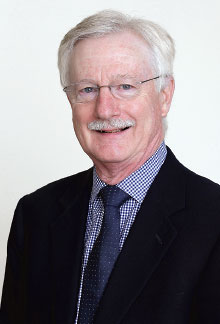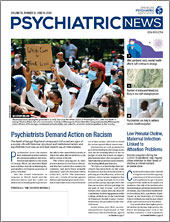Understanding the neurobiology of alcohol use disorder (AUD) can help address the stigma associated with the condition, George F. Koob, Ph.D., director of the National Institute on Alcohol Abuse and Alcoholism (NIAAA) explained in a presentation at the virtual APA Spring Highlights Meeting in April.
“Consideration of alcohol use disorder within a neurobiological framework reinforces alcohol use disorder as a health condition rather than as a moral failing,” he said. “This characterization may help reduce stigma, although stigma remains a pervasive barrier to treatment.”
In his presentation, Koob described a conceptual neurobiological framework for improving the diagnosis, prevention, and treatment of AUD. This framework accounts for how alcohol use can change neurotransmitters and the circuitry of the brain, particularly with respect to the emotional impact of withdrawal after a binge of heavy drinking. Koob explained that after drinking, people who are vulnerable to developing AUD may experience a phenomenon that he calls “hyperkatifeia” in which they feel increased emotional pain and distress. They then turn to drinking to relieve their emotional pain, further changing the neurotransmitters and circuitry of the brain.
“People with alcohol use disorder don’t recover their normal mood and emotional state after they drink,” Koob said. “Then they drink to fix the problem that alcohol caused. When you start doing that, that’s when you cross the line [to AUD], in my opinion.”
He added that several factors—including one’s genetic makeup, history of childhood trauma, and co-occurring mental illness—can make it even more difficult for some people to return to a normal emotional state after they drink.
“In my opinion the hangover you get from a binge is the beginning of … the change in neurotransmitters,” Koob said. He added that although neurotransmitters most likely recover in the aftermath of infrequent or early alcohol abuse, if people continue to binge or drink heavily, they may develop hyperkatifeia and eventually AUD.
Koob also discussed potential treatments. He explained that acamprosate, one of the three medications approved by the Food and Drug Administration for treating AUD, reverses the effects of glutamate, one of the neurotransmitters involved in craving. (The other medications are disulfiram and naltrexone.)
“There were quite a few clinical studies done for its approval, most of them showing pretty dramatic increases in abstaining [from alcohol use]. It works best for patients who have the low-level irritability and hyperkatifeia associated with abstinence,” he said.
Koob noted the promise of mifepristone (also known as RU 486), citing a study that showed it could reduce alcohol-cued craving and drinking in people with AUD while improving liver function.
Although understanding of AUD and treatment have come a long way since the NIAAA was created 50 years ago, significant challenges remain, Koob said.
“We have a lot of work to do on sex differences, how exposure to alcohol during adolescence makes one more vulnerable to alcohol use disorder, and the [impact] of aging. We certainly could do with more and better novel behavioral treatments,” he said, noting that the increase in telehealth in response to the COVID-19 pandemic could be a move in the right direction.
He added that there is a need to understand the neurobiology of the high co-occurrence of AUD with other mental illnesses, particularly posttraumatic stress disorder, anxiety disorders, and major depressive episodes. ■

